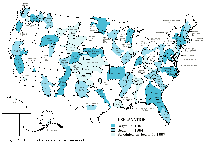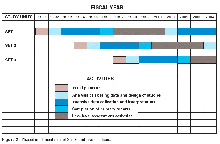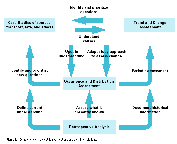
National Water-Quality Assessment (NAWQA) Program
Design of the National Water-Quality
Assessment Program:
Occurrence and Distribution of Water-Quality Conditions
United States Geological Survey Circular 1112
By Robert J. Gilliom, William M. Alley, and Martin E. Gurtz
INTRODUCTION
Over the past two decades, repeated evaluations of available water-quality
information have reached the conclusion that the United States needs
longterm national water-quality assessment to support effective water
policy and management (Wolman, 1971; James and others, 1983; Cohen and
others, 1988; National Research Council, 1990). Agreement on how to assess
water quality on a national scale, however, has been much more elusive.
One view is that a national water-quality assessment should be done by a
national statistical design with prescribed rules for the location and
timing of sampling and uniform methods and analyses; for example, Van Belle
and Hughes (1983). A contrasting view is that each hydrologic system
requires a custom-designed assessment that is based on its unique
hydrologic features and human influences (U.S. General Accounting Office,
1981). National statistical designs are best suited for producing
consistent descriptions of and monitoring large-scale water-quality
conditions that are persistent over time. They tend to be poorly suited
for assessing conditions that are short lived or unevenly distributed and
for explaining causes and effects. Studies that are custom designed for
each system can better assess specific water-quality conditions that are
variable and short lived and are suited for explaining causes and effects;
however, results for different systems cannot be consistently compared,
which makes regional- and national-level assessment of patterns and trends
in water-quality conditions difficult or impossible.
The National Water-Quality Assessment (NAWQA) Program of the U.S.
Geological Survey (USGS) is designed to describe the status of and trends
in the quality of the Nation's ground-water and surface-water resources and
to link assessment of status and trends with an understanding of the
natural and human factors that affect the quality of water. The design is
based on balancing the unique assessment requirements of individual
hydrologic systems with a nationally consistent design structure that
incorporates a multiscale, interdisciplinary approach for ground water and
surface water. By linking assessment of status and trends with an
understanding of processes and causes that operate at various spatial and
temporal scales, NAWQA can contribute most meaningfully to policies and
management actions that improve water quality. The program integrates
information about water quality at a wide range of spatial scales, from
local to national, and focuses on water-quality conditions that affect
large areas of the Nation, such as nutrients and pesticides associated with
large agricultural regions, or that occur in many small areas, such as
nutrients and pesticides associated with urban areas. Hirsch and others
(1988) and Alley and Cohen (1991) discussed the conceptual design of NAWQA
and its relation to other programs and design alternatives.
The building blocks of the NAWQA Program are Study-Unit Investigations in
60 major hydrologic basins (Study Units) of the Nation (fig. 1) (Leahy and others, 1990). The glossary
at the front of this report includes brief definitions of all study
components and related key terms used to describe the design, which are
indicated throughout the report with capital first letters. The 60 NAWQA
Study Units cover about one-half of the conterminous United States,
encompass 60-70 percent of national water use and of the population served
by public water supplies, and include diverse hydrologic systems that
differ widely in the natural and human factors that affect water quality.
This selection of Study Units ensures that the most important national
water-quality issues can be addressed by comparative studies. The Study
Units are divided into three groups, which are intensively studied on a
rotational schedule (fig. 2). The first
cycle of assessment for each group of 20 Study Units consists of 2 years of
initial planning and Retrospective Analysis of existing data, 3 years of
intensive data collection and analysis, and 6 years of report preparation
and low-level assessment activity before the second cycle of intensive data
collection and analysis begins. One-third of the Study Units are in the
intensive study phase at any given time, and the decadal cycle is repeated
perennially. The first complete cycle of intensive investigations of all
60 Study Units is scheduled to be completed in 2002.

(Click on image for a larger version, 46K) |
| Figure 1. Study Units of the National Water-Quality
Assessment.
| |

(Click on image for a larger version, 65K) |
|
Figure 2. Phased implementation of Study-unit
investigations.
|
|
The national assessment goals of NAWQA will be accomplished in two main
ways. First, the accumulation of consistent and comparable perennial
water-quality assessments for 60 of the largest and most significant
hydrologic systems of the Nation will stand alone as a major contribution
to our knowledge of regional and national water-quality conditions.
Second, National Synthesis builds on and expands the findings from
individual Study Units by interpreting results from multiple Study Units,
as well as existing information from studies of USGS and other agencies and
researchers, to produce regional and national assessments for priority
water-quality issues. National Synthesis develops comprehensive
assessments issue by issue at the national scale by comparative analysis of
Study-Unit findings. Two to three major water-quality topics are
simultaneously targeted for National Synthesis design and interpretation
during 6- to 9-year periods in a rotational schedule with other topics.
Pesticides and nutrients are the first two intensively studied National
Synthesis topics, which began in 1991; the third topic, which will begin in
1994, is volatile organic contaminants; and plans are being developed for
stream ecology.
External coordination at all levels is an integral component of the NAWQA
Program. Information exchange and coordination through Study-Unit liaison
committees help ensure that the water-quality information produced by the
program is relevant to regional and local interests. The liaison
committees are comprised of non-USGS members who represent a balance of
technical and management interests. Represented organizations will
include, as appropriate, Federal, State, interstate, and local agencies;
Indian Nations; and universities. In addition, a national
Federal/non-Federal advisory subcommittee specifically designated for the
NAWQA Program ensures that Federal and non-Federal interests and needs at
the regional and national levels are met.
Overview of Study-Unit Investigations
Study-Unit Investigations are designed to meet National Synthesis
requirements for consistent and integrated information and Study-Unit
requirements for assessing water quality with sufficient flexibility to
adapt to local conditions. Each Study-Unit Investigation consists of four
interrelated components:
- Retrospective Analysis. The review and analysis
of existing water-quality data provide a historical perspective on
water quality in the Study Unit and are used to assess strengths
and weaknesses of available information and to evaluate initial
priorities for water-quality management and study design.
- Occurrence and Distribution Assessment. This component
characterizes the broad-scale geographic and seasonal
distributions of water-quality conditions in relation to major
point and nonpoint contaminant sources and natural or background
conditions. A key objective is to fill gaps in existing data for
each Study Unit. Design features, such as chemical constituents
measured, media sampled, and spatial and temporal resolution, are
consistent among the Study Units. The Occurrence and Distribution
Assessment is the largest and most important component of the first
3-year intensive study phase in each Study Unit and serves as the
basis for the design of assessments of long-term trends and changes
and of more detailed case studies of specific water-quality issues.
- Trend and Change Assessment. Long-term trends and
changes in water-quality conditions are assessed on a decadal scale
in each Study Unit. Sampling strategies and coordinated efforts
with other programs and agencies are designed from the combined
results of Retrospective Analyses and Occurrence and Distribution
Assessments, and the concurrent development of information on
changes in land use, point sources, and other factors related to
changes in contaminant sources. Historical trends and changes will
be selectively assessed during the first cycle of each Study-Unit
Investigation by using existing data. The Trend and Change
Assessment will later be based on data collected between intensive
study phases and on data from successive 3-year intensive phases.
- Case Studies of sources, transport, fate, and
effects. Case Studies are detailed studies of selected
contaminants in selected surface- or ground-water systems to
address specific high-priority questions that concern the
characteristics, causes, and governing processes of
water-quality degradation. Case Studies are done at a wide
range of spatial and temporal scales during intensive study
phases. During the first cycle of investigation, Case
Studies are not emphasized because of the resource demands of
the initial Occurrence and Distribution Assessment, but their
emphasis will increase in future cycles.
Relations among the four components of Study-Unit Investigations are shown
in figure 3. The Retrospective Analysis
forms the basis for addressing what is already known and what needs to be
further investigated with respect to current water-quality conditions,
trends and change, and understanding causes and effects. The Occurrence
and Distribution Assessment builds on findings of the Retrospective
Analysis to complete a broad assessment of current water-quality
conditions. Periodic repetition of selected parts of the Occurrence and
Distribution Assessment during future intensive study phases is a key part
of the Trend and Change Assessment. Results of the Occurrence and
Distribution Assessment also are used to identify the most important
questions about sources, transport, fate, and effects to be addressed by
Case Studies. The Trend and Change Assessment focuses on document-ing
longterm trends and changes, results in new questions about causes and
effects, and identifies changes that need to be made in the periodic
intensive study phases. Case Studies are used to improve understanding of
selected questions about sources, transport, fate, and effects that arise
from all aspects of NAWQA investigations and often lead to changes in
assessment approaches over time. The interaction among the study
components centers on the Occurrence and Distribution Assessment, which
provides the foundation of data on which other components build.

(Click on image for a larger version, 65K) |
|
Figure 3. Components of Study-Unit Investigations and
their interrelations.
|
Purpose and Scope
This report summarizes the design of the Occurrence and Distribution
Assessment component of NAWQA Study-Unit Investigations, which is the
primary focus during the first cycle in all 60 Study Units and thus spans
the first decade of the program. The summary is presented in four main
parts: goals and major design components, Environmental Framework for
design, surface-water study design, and ground-water study design. The
primary emphasis is on the nature and interrelations of the study
components of the surface-water and ground-water designs. This report is
one of a series that will describe selected aspects of the NAWQA design to
encourage collaborative efforts with others in the water-resources
community and to foster continued evaluation and critical review of
approaches to national water-quality assessment.
Continue to Goals and Major Design
Components, Glossary, or return to Contents
http://water.usgs.gov/pubs/circ1112/introduction.html
Maintainer: h2o Webserver Team

